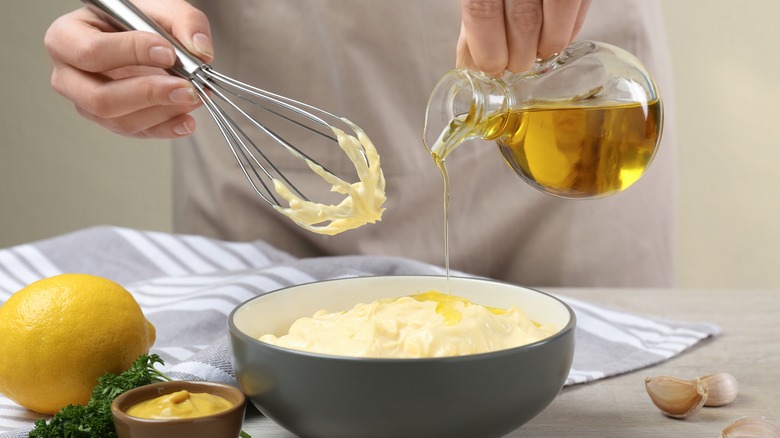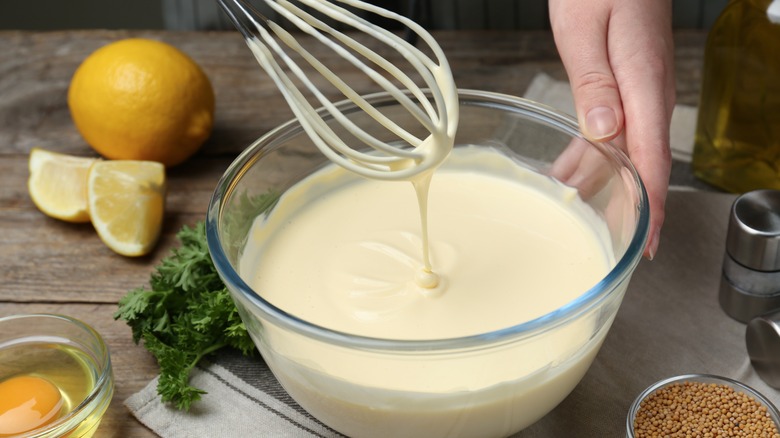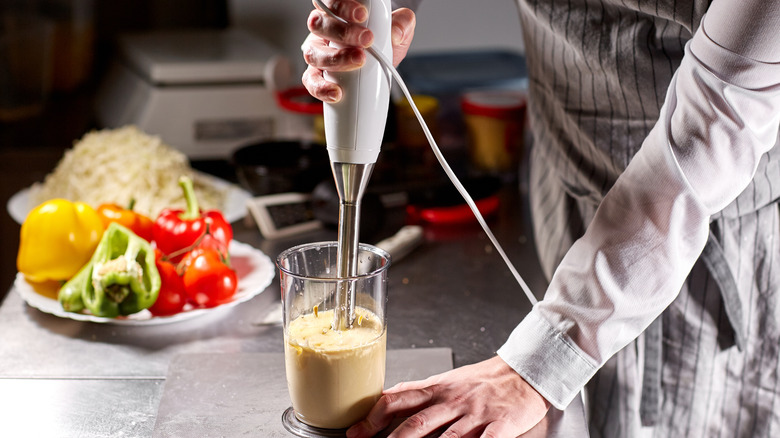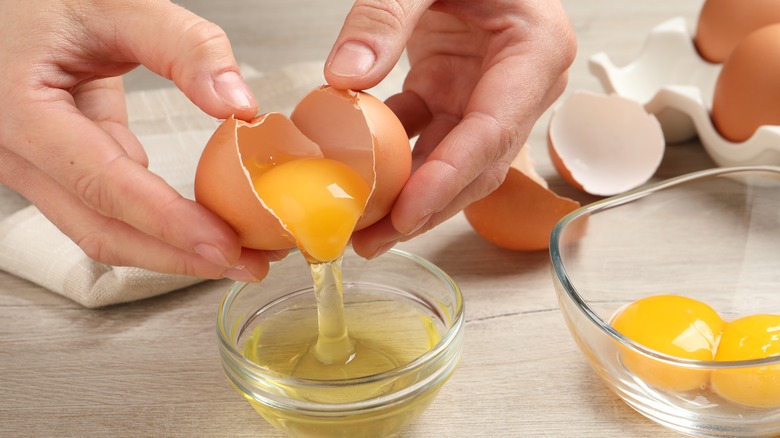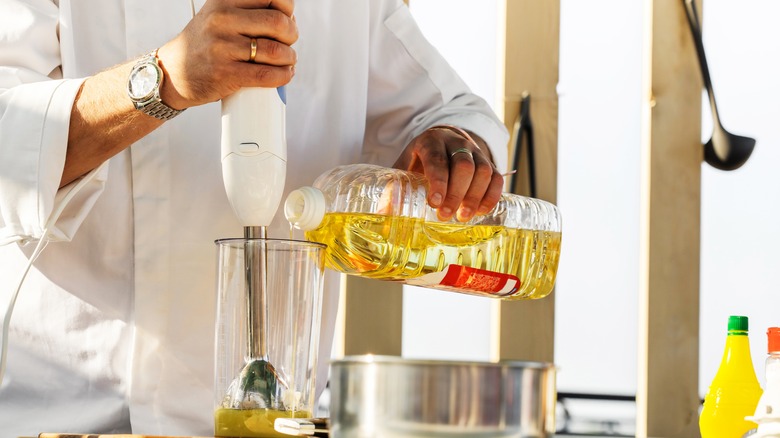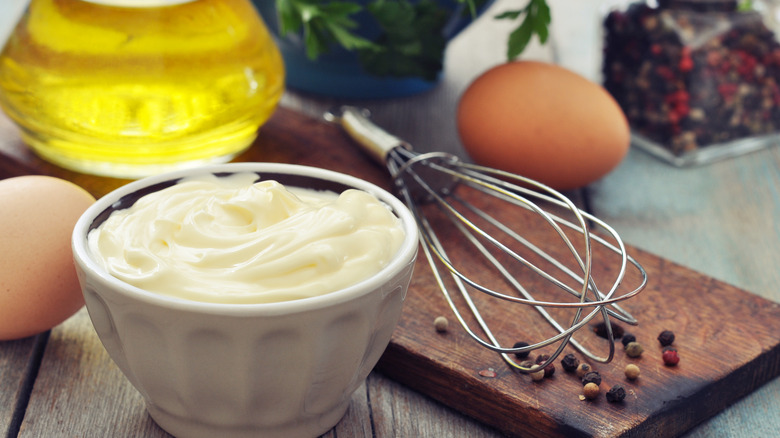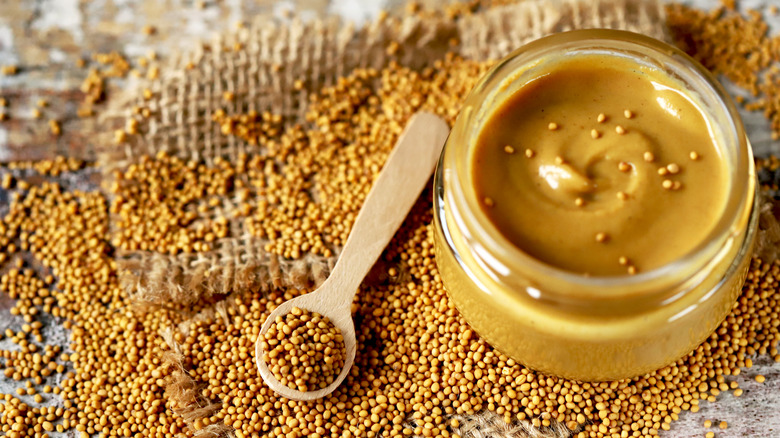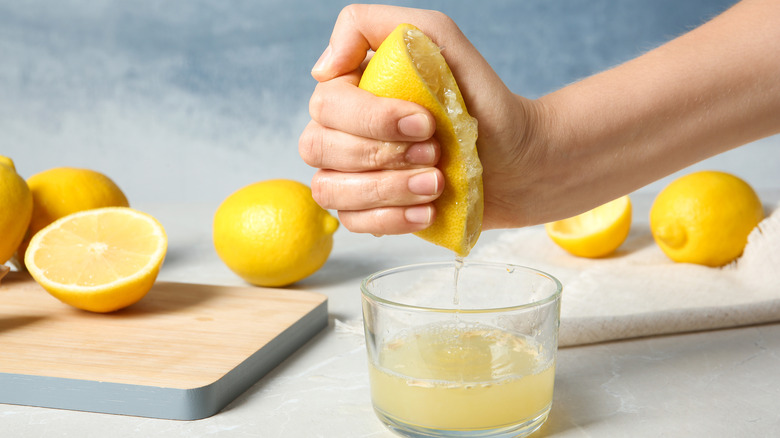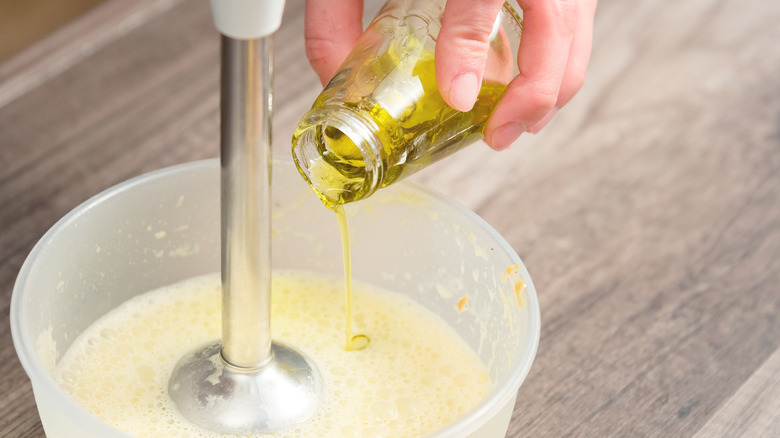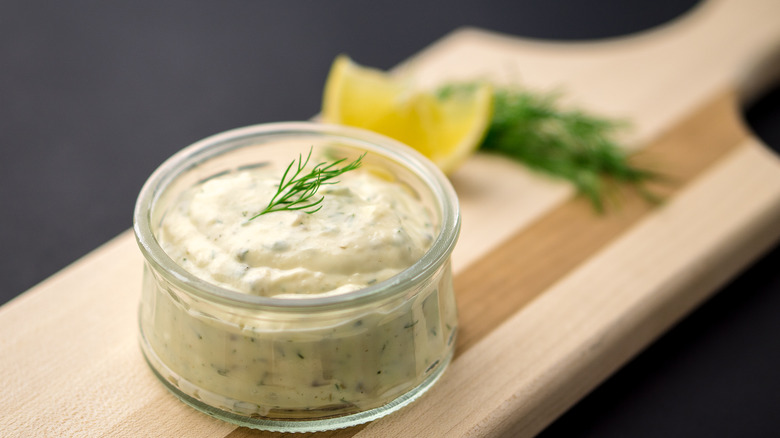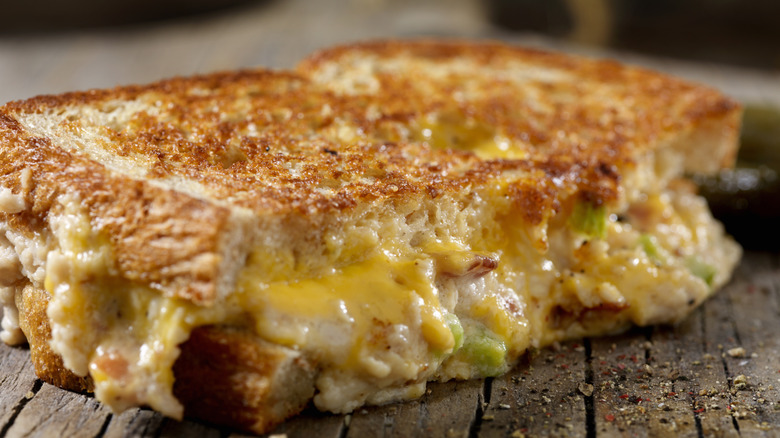Mistakes Everyone Makes With Homemade Mayonnaise
Mayonnaise is one of the most popular condiments in the world. According to Statista, in 2021, it even managed to knock off ranch and ketchup as America's favorite condiment, which is an impressive achievement. Most mayonnaise consumed in the U.S. is store-bought. Of course, nothing is more convenient than grabbing a jar from the grocery store, but the flavor and the quality cannot compare to the homemade version.
Mayonnaise gets a bad rap as an overly complicated condiment to be made at home, but the fear is mostly unjustified. It only incorporates a few ingredients — eggs, oil, mustard, and lemon juice or vinegar — that need to be whipped into a creamy mix. The technique can be a little daunting at first, but once you succeed and taste the first batch of homemade mayonnaise, you will be hooked for life.
To become a mayo expert, you should learn about the most common mistakes when attempting to make it at home. This will prevent you from repeating many classic oversights, and it will help you break all the misconceptions you had about homemade mayonnaise. Once you master the technique, you will probably never reach for that generic jarred version again.
Thinking that making homemade mayonnaise is overly complicated
The first big mistake many people make when it comes to homemade mayonnaise is believing it's too complicated and time-consuming to even try it. In reality, it can be one of the easiest things you can whip up in your home kitchen, and the preparation doesn't call for some crazy kitchen skills or extensive experience. Also, if you look at a classic homemade recipe, you'll notice that the ingredient list is short, and you probably have all of them at home. Let's not forget that the preparation usually requires one bowl, so there's no tiresome cleaning afterward.
So, if it is simple, quickly assembled, and does not call for rare or expensive ingredients, why did homemade mayonnaise earn the infamous status of being overly complicated? The answer might be in emulsification — a simple chemical process that immediately frightens people as explanations usually involve complicated scientific narratives and complex wording. Emulsification is the process of blending two ingredients that don't naturally mix — think of oil and water — but if you put enough power into it and add an emulsifier, the result will be a creamy, homogeneous mix, and the best mayonnaise you ever had. Of course, some tips and tricks through all possible mistakes will help you to master this technique, but just don't be afraid to try. If the first attempt fails, you can always try with another batch.
Believing good mayonnaise can only be made with a fancy blender
The most precise definition of mayonnaise would be to call it an emulsion. Essentially, you want to turn eggs, oil, and liquid — in this case vinegar or lemon juice — into a creamy mix that you can later use in your sandwiches, dips, and salads. If you look up mayonnaise recipes or watch your favorite TV chefs demonstrating the technique, you will probably see them using and recommending food processors or a hand immersion blender.
These blenders seem almost magical as they can whip up a batch of mayonnaise in less than a minute. But do not get discouraged if you don't own one. You can still create amazing homemade mayonnaise without the hand blender. The easiest way to blend it is to rely on your favorite whisk and do it the old-fashioned way. This straightforward process starts by adding all the ingredients, except oil, into a bowl and whisking them as you slowly add oil until your emulsion attains the desired consistency.
Mayonnaise whipped up by hand is more time-consuming, but it may be the easier route, especially for beginners. With immersion blenders, there is no way to control the process, as everything happens too fast. The old fashion hand-mixing is slower, so you can easily regulate the emulsification, stop adding oil, and whisk until the mayo has reached its ideal thickness.
Not using room temperature eggs
One of the most common mistakes when making homemade mayonnaise is fetching the eggs directly from the fridge and immediately adding them to the mix. Using cold eggs will not always send you down the catastrophic route that usually ends with broken emulsion, but they are one of the common culprits. Even if you pull out a successful emulsion, cold eggs usually slow the process.
The reason why room temperature eggs are better is all due to lecithin, a compound element that is found in certain foods, such as soybeans, milk, sunflower seeds, and egg yolks, which are the designated emulsifiers in mayonnaise. Lecithin has a unique property to attract oil and water, which makes it the ideal emulsifier as it will block the droplets of water and oil from clumping back together while keeping the emulsion stable. Research has proven that lecithin's emulsifying qualities in water and oil blends can "greatly improve" if heated (via Springer Link), meaning you have a greater chance of making a successful batch of mayo with room-temperature eggs.
The same rule applies to baking. If you are creaming butter and sugar and then adding eggs, you are again creating an emulsion. You want to avoid adding eggs directly from the fridge as the already softened and creamed butter will curdle in contact with cold eggs, and quickly break the stability.
Using strong-flavored oil
Due to its incredible flavor and supposed health benefits, olive oil is generally considered superior to other cooking oils, but it would be a mistake to use it when making homemade mayonnaise. The reason is that the rich, distinctive olive oil flavors easily overpower everything else in the blend. Olive oil, especially first-rate EVOO, will always have a touch of bitterness. This is usually a welcomed feature that gives olive oil backbone and character. However, when you blend mayonnaise, you break and release polyphenols, tiny particles in the oil that are inherently bitter. As they are dispersed through the emulsion, that bitterness becomes more pronounced, which can oftentimes be unpleasant. This is especially important if you use an immersion blender that works at high speed and is more effective at breaking polyphenols.
Generally, you want to avoid any strong-flavored oils in the mayonnaise. Apart from the bitterness in olive oil, many other vegetable oils have a flavor that is too strong and can easily take over and overwhelm the whole mix, ultimately ruining the flavor of mayonnaise. Surprisingly, it's best to go with the cheapest oil. Sunflower or canola oil are your safest options here. These oils are very mild in flavor, and though they will add a touch of aromatics, they will just be a subtle complement that will nicely blend with other ingredients. If you still want to incorporate a strong-flavored oil, it would be best to mix it with a more neutral option.
Adding oil at the wrong temperature
Though it is regularly emphasized that mayo calls for a specific type of oil and room-temperature eggs, the conversation often neglects to mention that the temperature of the oil is also crucial in getting that perfect mayo texture. As oil is the dominant ingredient in mayonnaise — fat usually makes over 70% of the mix (via ScienceDirect) — it is important to get it right.
Regardless of which oil you use, you also want to bring it to room temperature. If the oil is too cold, mixing and emulsifying will be more difficult. Ideally, you want to have it at the same temperature as the eggs, as this will allow the droplets to mix and disperse more efficiently. This will speed up the process, and in the end, it will create a more stable emulsion that will not break down easily.
The oil temperature is perhaps often neglected because oil is usually not refrigerated. But, if you like to keep your oil in the fridge, make sure to leave it outside to warm up a bit before you start mixing. Though room temperature oil is much better, do not go overboard and leave it in direct sunlight or try to heat it. Adding oil that is too warm might cook your eggs, leaving you with a disappointing, broken mess resembling scrambled eggs.
Adding too much oil too quickly
Sadly, oil temperature is not the only oil-related mistake people make when trying homemade mayonnaise. Adding oil to the mix is perhaps the trickiest part of the emulsification process, and adding too much oil at once is probably one of the biggest mistakes you can make. This issue mainly concerns the classic blender and hand-mixing methods that require a slower approach. The oil should be added in droplets until the emulsification process starts. If you pour all the oil at once, the water will not be able to penetrate through so much oil, and it will fail to break the fatty droplets to aid emulsification. They will not be evenly distributed, and your mayonnaise will not be able to attain the required consistency.
To do it properly, vigorously mix or blend eggs and mustard as you add a tiny amount of oil. Smaller amounts will not smother the eggs, and the mechanical movement will allow the water to penetrate slowly, separating the droplets and eventually dispersing them through the mix to create a creamy emulsion. With immersion blenders, the process is slightly different. You can add all the ingredients at once in a tall glass. The oil will naturally separate and stay on top, but when the blending starts, the head will gradually push the oil down and incorporate it into the watery mix. The process is essentially similar, but the blender works at a much higher speed.
Skipping mustard
Mustard is listed in most mayonnaise recipes. Though many believe it is mainly there to provide flavor, mustard, like egg yolks, is an excellent emulsifier. Due to its composition, mustard can also coat tiny oil particles, enabling them to blend in with other ingredients and prevent them from binding back together. This means that mustard is an additional component that will keep your mayonnaise firm and creamy.
If you want to use mustard only for its emulsifying qualities, you can choose any mustard you like or have on hand. However, if you want mustard to deliver flavor, you might want to choose carefully. Dijon is a classic and the most reliable choice, providing some lightly spicy, tangy, and earthy flavors that are always welcomed in mayonnaise. Spicy brown mustard is a great option if you want to add some heat, while the standard yellow mustard, with its subdued and more neutral profile, can be an option for those who do not wish to add a lot of mustardy flavors.
Can you leave out mustard in most recipes that use eggs? Yes, but it would be a fundamental mistake since additional help with emulsification is always needed, and mustard will provide a depth of flavor that will turn your bland, regular mayonnaise into a classy, gourmet condiment.
Believing that acidity will ruin the flavor and texture
If you never made mayonnaise before, you might be surprised to learn that some acidic component is a quintessential element in all recipes. Do not make the mistake of leaving it out just because you do not like the tart and sour taste. The acidity has many other functions besides enhancing the flavor.
Whether used separately or in tandem, lemon juice and vinegar are the two most common acidic ingredients in mayonnaise. Lemon juice is the unquestionable game-changer when it comes to flavor. The bright, citrusy notes will do wonders for fatty mayonnaise, and help balance all other flavors without making it sour. Oftentimes, the fat-laden mayonnaise can seem too heavy and thick, but a splash of lemon juice will immediately brighten it up, making it feel much lighter on the palate. Vinegar does not add much flavor complexity, but a touch of acidity is always welcomed.
Both ingredients also have preservation qualities. The citric acid in lemon juice and acetic acid in white vinegar will help to extend the shelf life and keep your mayonnaise less prone to spoilage. If you do not like the vinegary taste, remember that not all vinegar is created equal. Try experimenting with more subdued and mellow varieties, such as apple or rice vinegar.
Thinking that broken mayonnaise can't be fixed
Even the best chefs are not immune to mishaps that quickly lead to ruined dishes, so you should not be disappointed or discouraged if you experience something similar. Homemade mayonnaise does have the infamous attribute of being too complicated simply because the results are sometimes underwhelming. This usually happens because emulsification was not done correctly, resulting in a broken mayonnaise with blobs of fat separating from the egg mix. Even if you master all the tips and tricks of homemade mayonnaise, this does not guarantee that your effort will always be successful. However, if you end up with a sad, inhomogeneous mayo, don't despair. This does not mean that you should immediately throw it away.
Broken mayo can be fixed with several easy tricks. You can whip up part of the unsuccessful mix with water. When it turns into an airy whip, you can slowly add the rest of the mayonnaise in a slow, steady stream. This should result in a creamy, homogenous mix. The other method is to grab a new egg, or just the egg yolk if that is what the recipe suggests, and slowly whip it as you add the batch that could not hold shape. This will restart the emulsification, and if you do it slowly and carefully, you can make it creamy without any oily blotches.
Not upgrading homemade mayonnaise with additional ingredients
A very common mistake many people make is leaving the mayonnaise as is. If you get that silky smooth texture and ideal mayo creaminess, do not consider it a done deal. You may have the right consistency, but mayonnaise is such a perfect canvas to play with. You can easily tweak it with various add-ins to create an even better version that perfectly aligns with your taste.
Herbs are perhaps the most obvious addition. You can choose any herb, but freshly chopped parsley, basil, dill, or chives are fantastic options that add a beautiful herbal note, and can easily be paired with meat or veggies. If you want to be more creative, consider adding a splash of your favorite sauce. A dash of soy or Worcestershire sauce will impart that complex umami profile. To bring in some heat, think of adding a sprinkle of chili, smoky paprika, or finely chopped spicy pepper.
If you want to keep things more classic, you can copy aioli, a traditional sauce that is similar to mayonnaise but comes flavored with garlic. In this version, you can add garlic before you blend all the ingredients, but if you prefer a more subtle garlic aroma, the best suggestion is to bake garlic beforehand and then add it to the mix.
Not being creative enough with your homemade mayonnaise
Mayonnaise may be our favorite condiment used to dress up sandwiches, but it would be foolish to ignore its creative potential in the kitchen. Along with the classic way of using it as a dipping sauce or salad dressing, your homemade mayo can also be an excellent addition on top of sushi rolls, and it would blend nicely in as a pasta sauce. Mayonnaise can also make a perfect addition to marinades as it will help to keep the meat moist and juicy. Coating the outside of the grilled cheese sandwich with mayo is a familiar trick that creates a delectable crispy crust, but you can also use it to dress up veggies and steaks before you put them on the grill.
Besides savory options, mayonnaise is so versatile that you can even use it in desserts. Chocolate mayonnaise cakes were popularized in the 1940s, and they appeared in recipe books and restaurant menus. Hellmann's even had the recipe featured on its jars. The standard technique suggests adding mayonnaise to the cake batter to get moist cakes with a more pronounced flavor, but adding a spoonful of mayonnaise to frosting is an excellent way to make it rich and glossy. Cookie dough could also benefit from a small addition of mayonnaise. Most recipes these days suggest store-bought mayonnaise, but the homemade version can work even better, as it does not pack any questionable ingredients.
